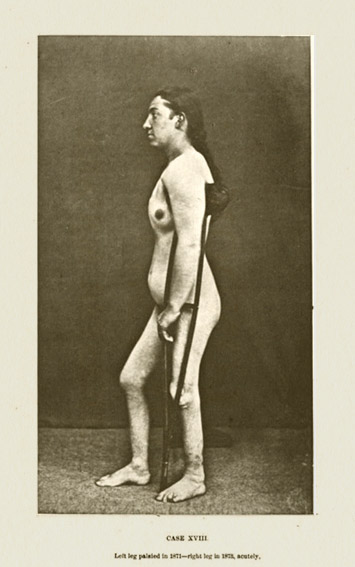
New York : D. Appleton and company, 1874, 1875.
Description : frontis., [1]-39 p. ; ill.: 1 phot. —&— [1]-18 p. ; ill.: tbls. ; 23.8 cm.
Photograph : collotype of the clinical subject, standing nude, lateral view.
Subject : Spine — Paralysis.
Notes :
The reduction in temperature was not as great as in the cases of infantile spinal paralysis. In the case represented in the photograph the lower limbs are very cold to the touch, and look purplish. No bed-sore occurred in any case, nor were lesions of the skin, nails, or hair, noted.—Page-27.

Edward C. Seguin was the son of Edouard Seguin (1820-1880) whose psycho-physiological method, published in 1866, advanced the standard of care for the feeble-minded (v. GM-4936.1). The elder Seguin trained under Itard and Esquirol before emigrating to America in 1848 with his five year-old son. Growing up in Ohio, Edward Seguin received private instruction until he entered the New York Academy of Medicine, graduating in 1864. Following in the footsteps of his father, he returned to Europe to study under Charcot and other notable neurologists. An early paper of his titled, "The use of the thermometer in clinical medicine" (1866, CMJ»»), was derived from the work of Wunderlich and included a chart of temperature readings that he designed with the help of his colleague, Dr. William Henry Draper (1830-1901). It was the first chart of vital signs published in America. As a lecturer at the New York Academy, Doctor Seguin made countless small but valuable contributions toward the cultivation of American neurology. Preeminent was his work on the localization of spastic spinal paralysis, anticipating Charcot's weightier research, but to which he gave the regrettable name, "tetanoid paraplegia."
